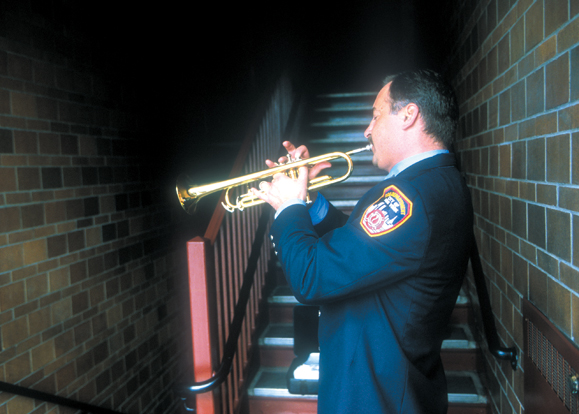Practicing “taps” prior to firefighter Michael Lynch’s memorial service.
“What kind of guy was Michael Lynch?”
“I’ll tell you what he was,” said one of his firefighter coworkers. “There are two different kinds of guys that get on the Department. Those that got on the job, and those that get into the job. He was a guy that got into his work.”
Lynch was just 33 years old, married for five years and had two kids. He worked out a firehouse in mid-Manhattan, just a few blocks from the Ed Sullivan Theater and Broadway itself. Lynch had been on the job 11 years and was close to being promoted.
Ladder Company 4 – along with Engine 54 – responded from their station after the first Tower was hit. They were among many firefighters who went dashing upstairs while the occupants were fleeing the other way. Amid the chaos, those escaping actually stopped and applauded the firefighters – wearing over 50 pounds of gear and carrying tools and equipment – who were running up the stairwells.
The aircraft that ripped through the Tower shared all the elevator cables leaving many dangling, and occupants trapped on the mezzanine level. Lynch and his partner came upon an elevator, heard people screaming for help and stopped. They were unable to pry the doors open. Lynch came up with the idea of using a Hurst tool, commonly referred to as the “Jaws of Life,” to pry open the doors.
He ran down the stairway he had just climbed, went out to the truck, got the Hurst tool (which is heavy in itself), and then tore back upstairs to the elevator.
He never came back. Neither did 14 other firefighters from Ladder 4 and Engine 54, which were virtually wiped out when the Tower crashed down on them.
Lynch’s body has not been recovered. ♦
Note: Michael Lynch’s body was eventually recovered from the bottom of an elevator shaft. He died helping to extricate people trapped in an elevator in the South Tower’s lobby.
Read A Hero Remembered to learn more about Michael Lynch.


Leave a Reply